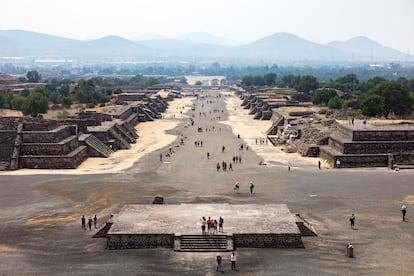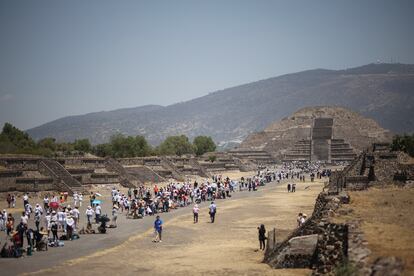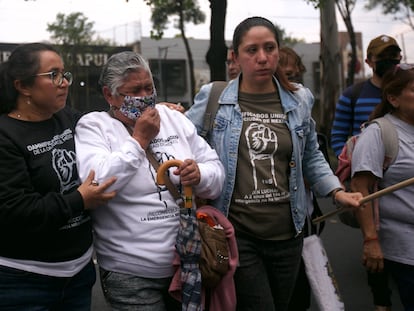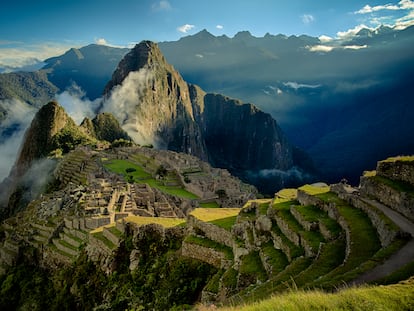Five megathrust earthquakes destroyed the city-state of Teotihuacán
A Spanish-Mexican study reveals the reasons that led the population of this impressive Mayan civilization city to flee to safer places in the year 650


Why the impressive city-state of Teotihuacán — one of the most important pre-Hispanic centers of power in Central America — disappeared is one of the great mysteries of world archaeology. Experts agree that it went from housing more than 100,000 inhabitants in the second century to just under 5,000 in the seventh. Was it affected by war, plague, famine, or another devastating event?
Now the study Teotihuacán ancient culture affected by megathrust earthquakes during the Early Epiclassic Period, which has just been published in the Journal of Archaeological Science, reveals a surprising answer: Five major seismic movements, occurring approximately between the years 100 and 650, destroyed or severely damaged the city’s main buildings and led directly to the collapse of this civilization, despite the desperate efforts of its inhabitants to try to rebuild it.
“The possibility that repetitive megathrust earthquakes in the Mesoamerican Trench (Pacific coast) could be responsible for the spatial pattern of the building damage [...] does not conflict with other existing theories about the Teotihuacán abrupt collapse, considering that the sudden overlapping of natural disasters like earthquakes could increase internal warfare (uprising), and civil unrest,” states the article published by specialists from the Geological and Mining Institute of Spain (IGME-CSIC), the University of Barcelona, the University of Salamanca, the Autonomous University of Madrid, The Politécnica University of Madrid, and the Michoacana University of San Nicolás de Hidalgo (Mexico).
The Teotihuacán culture flourished in the Central Valley of Mexico between the years 150 and 650. It was a civilization that built a society that was able to erect splendid pyramids and beautiful temples. Specialists believe that, curiously, its spectacular and rapid urban and technological growth had its origin in two volcanic eruptions between the years 50 and 300, which devastated the also thriving city of Cuicuilco. The city’s disappearance under the lava and ashes cleared the way for Teotihuacán to become a major center of civilization.
This city-state extended approximately 8.5 square miles at its peak. It is estimated that about 100,000 people lived there, although some authors have raised the figure to 200,000. It had three main buildings: the Pyramids of the Sun (65 meters high) and the Moon (45 meters), as well as the Temple of the Feathered Serpent or Quetzalcóatl. Around them were grouped the residential areas of the middle and upper classes. The urban layout was organized along a large north-facing avenue of more than a mile in length, the so-called Avenida de los Muertos (the Avenue of the Dead).
But from the year 550, there was “a sharp decrease in the population, fires, and collapsed buildings.” These events mark what is known as the Late Classic and Early Epiclassic Periods of the Central Valley of Mexico: in the face of so many misfortunes, the Teotihuacans decided to abandon the city and settled in nearby Xochicalco and Tula, which in turn gave rise to the flourishing the new Toltec culture.
To reach its conclusions, the report, co-written by experts Raúl Pérez; Natalia Moragas; Javier Elez; Pablo Silva; Jorge Giner; Miguel Ángel Rodríguez-Pascua; Adrià Ramos; María A. Perucha; Elvira Roquero; and Víctor Garuño, is based on detailed study of the so-called EAE (earthquake archaeological effects) on the temple of the Feathered Serpent and the Pyramids of the Sun and the Moon, in addition to the archaeological information compiled by other experts in previous years.

Spanish and Mexican specialists believe that the megathrust earthquakes that destroyed the city originated in the so-called Mesoamerican Trench in the Pacific Ocean. “The spatial pattern of the EAEs [...] indicate a seismic shock direction from southwest to the northeast. This means the Middle American Trench could be the seismic source. In this case, a megathrust earthquake [...] could explain the EAEs and the seismic intensity affecting the city.” However, they admit that the earthquakes could have had another origin close to the city, although they consider it less likely.
What they are clear about is that there were five enormous earthquakes, between the years 100 and 650, that forced the Teotihuacans to modify and reinforce their architectural style in the Pyramids of the Sun and the Moon, as well as in the reconstruction of the Temple of the Feathered Serpent. They sought to minimize the effects of new earthquakes. But these modifications were not enough given the magnitude of the earthquakes that were going to arrive. An example of these anti-seismic measures are the well-known “locking” of the ashlars, which prevent the horizontal movement of the stone blocks, in much the same way as the Incas did in Machu Picchu.
According to the experts, the city suffered “at least, two strong destructive earthquakes (Intensity VIII-IX), having a great impact on the development of the architectural styles.” The first occurred between the years 1 and 150 and the second between the years 405 and 505.

Three other earthquakes, although of lower intensity (Intensity VIII) also affected the city around the years 225, 400, and 600. “The conjugate action of ancient earthquakes can explain the archaeoseismic damage documented in some places, but the last two earthquakes before its abandonment in c. 650, are the most likely cause.”
The EAEs described include broken and fragile corners affecting the western stairs of the Pyramid of the Sun and the New and Old Temples of the Feathered Serpent. Based on scientific evidence, the authors completely rule out that this damage could be due to deliberate human intervention or climatic erosion of the basalt stone stairs.
“The combination of the high seismic energy released by repetitive earthquakes, the seismic frequency amplitude, and Lake Texcoco sediments infilling [about 50 kilometers away] could explain the deformation patterns observed in the pyramids and temples throughout the entire the history of Teotihuacán,” they point out. Finally, they call for a “comprehensive analysis of liquefaction and soft-sediment deformation from the lake,” because it would help establish the exact date when the inhabitants of Teotihuacán surrendered to the forces of nature.
You can follow MATERIA on Facebook, < i>X e Instagram, or sign up here to receive our weekly newsletter.
Tu suscripción se está usando en otro dispositivo
¿Quieres añadir otro usuario a tu suscripción?
Si continúas leyendo en este dispositivo, no se podrá leer en el otro.
FlechaTu suscripción se está usando en otro dispositivo y solo puedes acceder a EL PAÍS desde un dispositivo a la vez.
Si quieres compartir tu cuenta, cambia tu suscripción a la modalidad Premium, así podrás añadir otro usuario. Cada uno accederá con su propia cuenta de email, lo que os permitirá personalizar vuestra experiencia en EL PAÍS.
¿Tienes una suscripción de empresa? Accede aquí para contratar más cuentas.
En el caso de no saber quién está usando tu cuenta, te recomendamos cambiar tu contraseña aquí.
Si decides continuar compartiendo tu cuenta, este mensaje se mostrará en tu dispositivo y en el de la otra persona que está usando tu cuenta de forma indefinida, afectando a tu experiencia de lectura. Puedes consultar aquí los términos y condiciones de la suscripción digital.
More information
Archived In
Últimas noticias
Welcome to the post-religion era: The idea of Christianity as the absolute truth has become obsolete
‘I thought you would like it’: The risky sexual practice popularized by TV shows and TikTok
The digitalization of tourism: ‘They promise experiences and gave us the worst possible one’
Mexican peso defies uncertainty with forecasts of a new period of stability in 2026
Most viewed
- Sinaloa Cartel war is taking its toll on Los Chapitos
- Oona Chaplin: ‘I told James Cameron that I was living in a treehouse and starting a permaculture project with a friend’
- Reinhard Genzel, Nobel laureate in physics: ‘One-minute videos will never give you the truth’
- Why the price of coffee has skyrocketed: from Brazilian plantations to specialty coffee houses
- Silver prices are going crazy: This is what’s fueling the rally










































